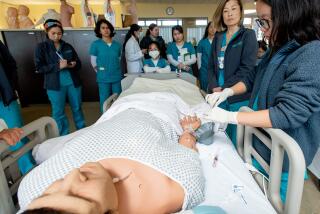Nursing Rules Not Ready Yet
Finding the right nurse-to-patient ratio for California hospitals is proving harder than expected, delaying the release of new state-mandated staffing guidelines.
The state has yet to finish developing the regulations, which were supposed to take effect by Tuesday. They may not be ready for several months, according to officials.
âWeâre not going to meet the Jan. 1 deadline,â said Lea Brooks, spokeswoman for the state Department of Health Services, the agency charged with setting the ratios. âItâs a very complex, very time-consuming process and weâre still analyzing the data we gathered.â
Gov. Gray Davis signed a bill in 1999 requiring minimum staffing levels in hospital units, making California the first state to do so. Such requirements already existed for some hospital areas, including intensive care units and operating rooms.
Nurses unions support requiring levels as high one nurse for every three patients, saying more nurses would ease excessive workloads, improve patient care and make the job more attractive amid a shortage.
The hospital industry has proposed levels as low as one nurse for every 10 patients, saying that there arenât enough nurses available for blanket increases, that hospitals should have discretion on staffing levels and that there is no proof that more nurses equal better care.
Both sides have spent months waiting for the new guidelines.
Jan Emerson, a spokeswoman for the California Healthcare Assn., said the hospital industry group is âphilosophically opposedâ to mandatory staffing levels, but would wait until the new rules are out before taking a position. âLetâs see what the regulations are and what the plan is,â she said.
Jill Furillo, director of government relations for the California Nurses Assn. union, was equally diplomatic about the delay.
âI understand that [the state] is working really hard on them,â she said. âWe need them, but we also want to make sure that whatever they do, they do it right.â
The rules were supposed to take effect last January, but lacking an agreed-upon âmagic numberâ of the optimal nurse-to-patient ratio, the state postponed implementation for a year to develop guidelines.
The Department of Health Services took proposals from the hospital and nurses associations, commissioned staffing-ratio studies by the University of California and made unannounced visits to 80 acute-care hospitals throughout the state to observe the quality of care at different staffing levels and different times of day, according to Brooks. She said a public-comment period of at least 45 days will follow issuance of the draft regulations.
âWeâre committed to holding meetings at sites throughout the state in recognition of the high interest in this issue,â she said.
Gov. Davis cited the âerosion in the quality of patient careâ when he signed the bill, at a time when managed-care cost pressures led many hospitals to reduce nursing staff.
California ranked next-to-last in a March 2000 federal survey measuring statesâ ratio of nurses per 100,000 residents, with 544. The national average was 782.
(BEGIN TEXT OF INFOBOX / INFOGRAPHIC)
Nurse Ratios
The Department of Health and Human Services conducted a national sample of registered nurses in March 2000. California ranked 49th of the 50 states in the ratio of registered nurses to residents.
Most nurses per 100,000 residents
1. Massachusetts: 1,194
2. South Dakota: 1,128
3. Rhode Island: 1,101
4. North Dakota: 1,096
5. Iowa: 1,060
Fewest nurses per 100,000 residents
46. Oklahoma: 635
47. Arizona: 628
48. Texas: 606
49. California: 544
50. Nevada: 520
National average: 782
More to Read
Sign up for Essential California
The most important California stories and recommendations in your inbox every morning.
You may occasionally receive promotional content from the Los Angeles Times.






![[20060326 (LA/A20) -- STATING THE CASE: Marchers organized by unions, religious organizations and immigrants rights groups carry signs and chant in downtown L.A. "People are really upset that all the work they do, everything that they give to this nation, is ignored," said Angelica Salas of the Coalition of Humane Immigrant Rights. -- PHOTOGRAPHER: Photographs by Gina Ferazzi The Los Angeles Times] *** [Ferazzi, Gina -- - 109170.ME.0325.rights.12.GMF- Gina Ferazzi/Los Angeles Times - Thousands of protesters march to city hall in downtown Los Angeles Saturday, March 25, 2006. They are protesting against House-passed HR 4437, an anti-immigration bill that opponents say will criminalize millions of immigrant families and anyone who comes into contact with them.]](https://ca-times.brightspotcdn.com/dims4/default/34f403d/2147483647/strip/true/crop/1983x1322+109+0/resize/840x560!/quality/75/?url=https%3A%2F%2Fcalifornia-times-brightspot.s3.amazonaws.com%2Fzbk%2Fdamlat_images%2FLA%2FLA_PHOTO_ARCHIVE%2FSDOCS%2854%29%2Fkx3lslnc.JPG)



